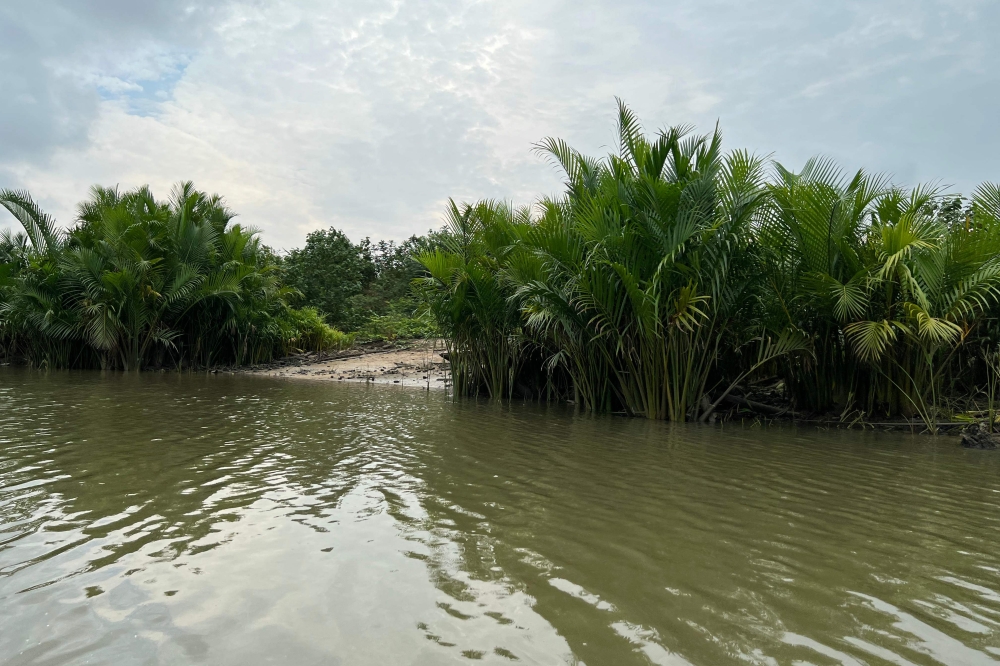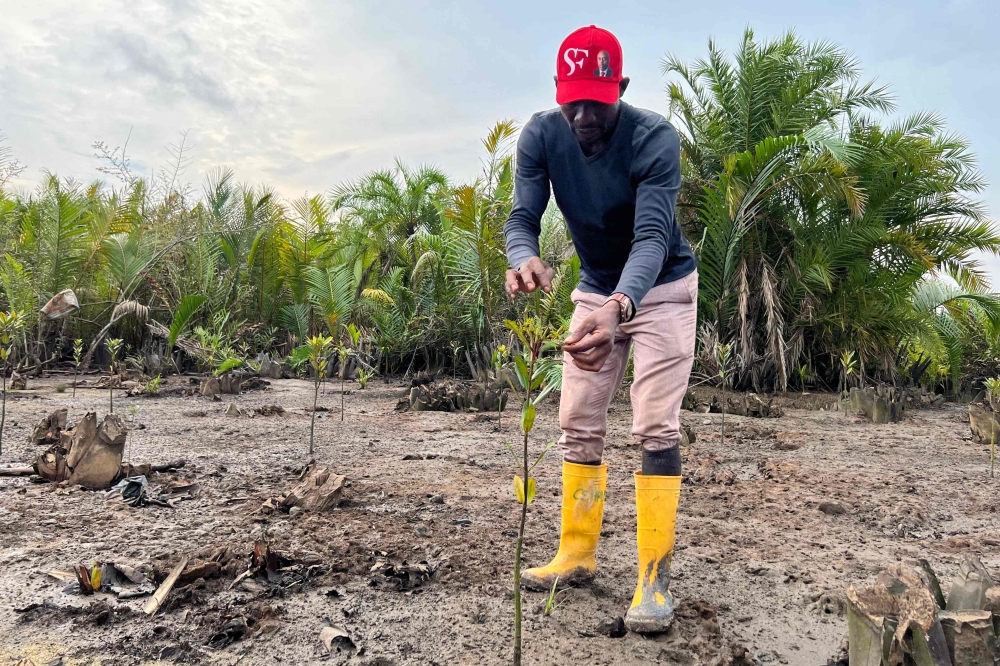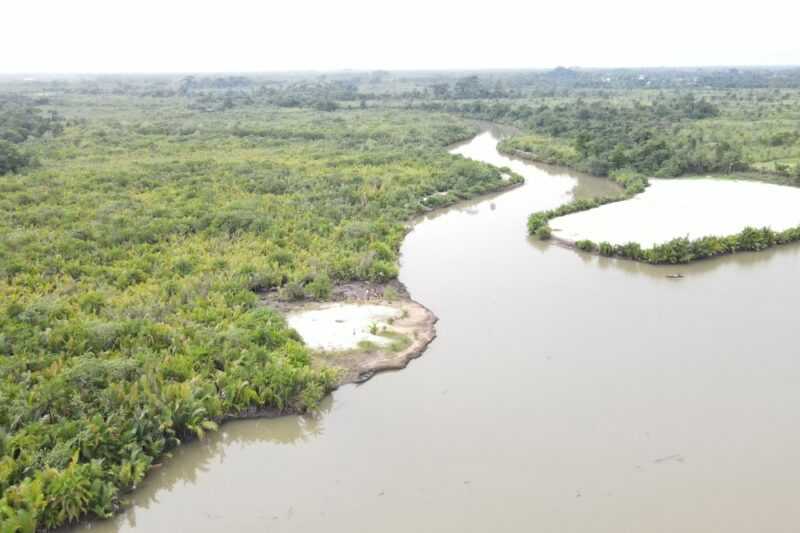PORT HARCOURT (Nigeria), July 1 — On a riverbank within the Niger Delta, a bunch of residents in rubber boots has been working to restore one in every of Nigeria’s most valuable and broken ecosystems — its mangrove forests.
The crew members plunge their shovels into the mud and slot in saplings on the website in Bundu, a shanty city on the outskirts of the southern oil metropolis Port Harcourt.
In current years, human exercise has destroyed swathes of the world’s mangrove forests, which type an important barrier in opposition to the tides and a sanctuary for wildlife.
But on this a part of the Delta — stricken by leaks from multinational oil firm pipelines and a bunch of different threats — a area people chief is pushing forward with a challenge to restore the spoiled forests.
“We’re going to deliver our mangroves back to life,” stated fisherman David Oba, 53, who represents round 10,000 folks within the city.
This aerial view reveals mangrove and nipa palm tree forest alongside a river in Kono village in Nigeria June 11, 2024. — eNM pic
‘Refuge’
Mangrove forests are a biodiversity paradise. The specialist saltwater timber’ big root networks present nurseries for juvenile fish, that are essential to supporting shares.
The forests teem with life above water too — they’re “refuges” for an array of birds that nest of their branches, defined Ijeoma Vincent-Akpu, a professor on the University of Port Harcourt.
Vincent-Akpu stated the timber additionally shield in opposition to coastal erosion, storms and flooding, offering a key protect within the face of local weather change.
Nigeria boasts a few of the highest mangrove protection on the planet and greater than wherever else in Africa — however its forests are shrinking.
The nation had round 8,442 sq. kilometres of mangrove forest in 2020, in accordance to the monitoring platform Global Mangrove Watch.
Between 1996 and 2020 it misplaced 161.9 sq. kilometres of mangroves, the group stated — round two per cent of the entire and an space equal to greater than 22,500 soccer pitches.
Experts say that is primarily due to human exercise within the continent’s most populous nation.

This {photograph} reveals nipa palm tree forest alongside a river in Kono village on June 11, 2024.
Oil pollution
In Bundu, round 30 folks have realized how to restore mangrove ecosystems with the assistance of a Nigerian NGO, the Centre for Environment, Human Rights and Development.
They have been by way of a number of weeks’ coaching, stated Nabie Nubari Francis, coordinator of the NGO, which has been operating the challenge in three different communities within the Delta for almost 15 years.
Priority is given to coaching group leaders to allow them to move on their expertise. David Oba stated he had educated 70 folks in Bundu since beginning the challenge there a number of months in the past.
One of the best threats to the mangroves is pollution from the multinational oil business within the Delta. Residents say entire areas have been worn out by spills.
Oil spills are frequent within the area due to an absence of pipeline upkeep in addition to vandalism. Over the final 5 years, the National Oil Spill Detection and Response Agency has recorded virtually 3,870 spills in Nigeria, primarily within the Niger Delta.
Kwani Dick Velvet, a retired journalist, recalled the primary sapling he planted in his group, purchased from a close-by nursery.
“If it was not for the truth that folks got here and planted some mangroves, this place would have been a really open discipline,” he stated, pointing to an space that he stated was hit by an oil spill in 2020.
Residents stated the spill was attributable to vandals concentrating on an oil pipeline.
“When the spillage happens, we can’t fish,” 38-year-old fisherman Peter Opugulaya instructed eNM.

Colin Love, Kono village farmer, vegetation a mangrove stem on the restoration website in Kono village June 11, 2024. — eNM pic
Invasive palms
Oil will not be the one drawback. Nigeria’s mangroves are being broken by unlawful logging, waste dumping and concrete enlargement.
They face one other risk, too — the unfold of Nipa palms, an invasive species that has muscled in among the many mangroves.
Imported from South Asia and Oceania, the palms are used for baskets and roofing, however don’t present shelter for fish just like the mangroves’ arched roots.
Colin Love, from Kono village round 70 kilometres from Port Harcourt, complained the palms had taken root “all over the place”.
The 40-year-old stated he was planting mangroves “in order that the fish will nonetheless come back for us.”
On a go to to the Delta earlier this yr, Nigeria’s atmosphere minister promised to work with native authorities to shield mangroves and mitigate the results of local weather change.
Four years earlier, the federal government introduced its intention to launch a nationwide mangrove restoration plan, nevertheless it was by no means applied.
Residents stated the federal government has been gradual to act, prompting them to take measures into their very own fingers.
“We are serving to one another,” stated 48-year-old driver and Kono resident Prince Nwilee, saying that communities have been prepared to share saplings with their neighbours.
“We usually are not sitting by and doing nothing,” he stated. — ETX Studio








